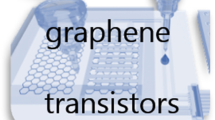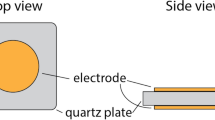Abstract
We demonstrate a magnetic microsystem capable of detecting nucleic acids via the size difference between bare magnetic beads and bead compounds. The bead compounds are formed through linking nonmagnetic beads and magnetic beads by the target nucleic acids. The system comprises a tunnel magneto-resistive (TMR) sensor, a trapping well, and a bead-concentrator. The TMR sensor detects the stray field of magnetic beads inside the trapping well, while the sensor output depends on the number of beads. The size of the bead compounds is larger than that of bare magnetic beads, and fewer magnetic beads are required to fill the trapping well. The bead-concentrator, in turn, is capable of filling the trap in a controlled fashion and so to shorten the assay time. The bead-concentrator includes conducting loops surrounding the trapping well and a conducting line underneath. The central conducting line serves to attract magnetic beads in the trapping well and provides a magnetic field to magnetize them so to make them detectable by the TMR sensor. This system excels by its simplicity in that the DNA is incubated with magnetic and nonmagnetic beads, and the solution is then applied to the chip and analyzed in a single step. In current experiments, a signal-to-noise ratio of 40.3 dB was obtained for a solution containing 20.8 nM of DNA. The sensitivity and applicability of this method can be controlled by the size or concentration of the nonmagnetic bead, or by the dimension of the trapping well.

If biological targets are present, they link magnetic beads and fluorescent beads. This results in less magnetic beads to be on the surface of magnetic sensor, causing a smaller signal, thus biological targets are detected.






Similar content being viewed by others
References
Baselt DR, Lee GU, Natesan M, Metzger SW, Sheehan PE, Colton RJ (1998) A biosensor based on magnetoresistance technology. Biosens Bioelectron 13:731–739. doi:10.1016/S0956-5663(98)00037-2
Schotter J, Kamp PB, Becker A, Pühler A, Reiss G, Brückl H (2004) Comparison of a prototype magnetoresistive biosensor to standard fluorescent DNA detection. Biosens Bioelectron 19(10):1149–1156. doi:10.1016/j.bios.2003.11.007
Martins VC, Germano J, Cardoso FA, Loureiro J, Cardoso S, Sousa L, Piedade M, Fonseca LP, Freitas P (2010) Challenges and trends in the development of a magnetoresistive biochip portable platform. J Magn Magn Mater 322(9):1655–1663. doi:10.1016/j.jmmm.2009.02.141
Cardoso F, Costa T, Germano J, Cardoso S, Borme J, Gaspar J, Fernandes J, Piedade M, Freitas P (2012) Integration of magnetoresistive biochips on a CMOS circuit. IEEE Trans Magn 48(11):3784–3787. doi:10.1109/TMAG.2012.2198449
Mujika M, Arana S, Castaño E, Tijero M, Vilares R, Ruano-López JM, Cruz A, Sainz L, Berganza J (2009) Magnetoresistive immunosensor for the detection of Escherichia coli O157:H7 including a microfluidic network. Biosens Bioelectron 24(5):1253–1258. doi:10.1016/j.bios.2008.07.024
Miller MM, Sheehan PE, Edelstein RL, Tamanaha CR, Zhong L, Bounnak S, Whitman LJ, Colton RJ (2001) A DNA array sensor utilizing magnetic microbeads and magnetoelectronic detection. J Magn Magn Mater 225(1–2):138–144. doi:10.1016/s0304-8853(00)01242-7
Graham DL, Ferreira HA, Feliciano N, Freitas PP, Clarke LA, Amaral MD (2005) Magnetic field-assisted DNA hybridisation and simultaneous detection using micron-sized spin-valve sensors and magnetic nanoparticles. Sensors Actuators B Chem 107(2):936–944. doi:10.1016/j.snb.2004.12.071
Shen W, Schrag BD, Carter MJ, Xie J, Xu C, Sun S, Xiao G (2008) Detection of DNA labeled with magnetic nanoparticles using MgO-based magnetic tunnel junction sensors. J Appl Phys 103(7):07A306. doi:10.1063/1.2832880
Xu L, Yu H, Akhras MS, Han S-J, Osterfeld S, White RL, Pourmand N, Wang SX (2008) Giant magnetoresistive biochip for DNA detection and HPV genotyping. Biosens Bioelectron 24(1):99–103. doi:10.1016/j.bios.2008.03.030
Koets M, van der Wijk T, van Eemeren JTWM, van Amerongen A, Prins MWJ (2009) Rapid DNA multi-analyte immunoassay on a magneto-resistance biosensor. Biosens Bioelectron 24(7):1893–1898. doi:10.1016/j.bios.2008.09.023
Martins VC, Cardoso FA, Germano J, Cardoso S, Sousa L, Piedade M, Freitas PP, Fonseca LP (2009) Femtomolar limit of detection with a magnetoresistive biochip. Biosens Bioelectron 24(8):2690–2695. doi:10.1016/j.bios.2009.01.040
Gijs MAM (2004) Magnetic bead handling on-chip: new opportunities for analytical applications. Microfluid Nanofluid 1:22–40. doi:10.1007/s10404-004-0010-y
Wang S, Bae S, Li G, Sun S, White R, Kemp J, Webb C (2005) Towards a magnetic microarray for sensitive diagnostics. J Magn Magn Mater 293(1):731–736. doi:10.1016/j.jmmm.2005.02.054
Giouroudi I, Kosel J (2010) Recent progress in biomedical applications of magnetic nanoparticles. Recent Patents Nanotechnol 4(2):111–118. doi:10.2174/187221010791208795
Gooneratne CP, Giouroudi I, Liang C, Kosel J (2011) A giant magnetoresistance ring-sensor based microsystem for magnetic bead manipulation and detection. J Appl Phys 109(7):07E517. doi:10.1063/1.3536822
Gooneratne CP, Liang C, Giouroudi I, Kosel J (2011) A magnetic particle micro-trap for large trapping surfaces. Procedia Eng 25:1201–1204. doi:10.1016/j.proeng.2011.12.296
Gooneratne CP, Giouroudi I, Kosel J (2012) A planar conducting micro-loop structure for transportation of magnetic beads: an approach towards rapid sensing and quantification of biological entities. Sens Lett 10(3–4):770–774. doi:10.1166/sl.2012.2583
Li F, Giouroudi I, Kosel J (2012) A biodetection method using magnetic particles and micro traps. J Appl Phys 111(7):07B328. doi:10.1063/1.3678304
Li F, Kosel J (2012) A magnetic method to concentrate and trap biological targets. IEEE Trans Magn 48(11):2854–2856. doi:10.1109/TMAG.2012.2202644
Gooneratne CP, Giouroudi I, Kosel J (2013) Microdevice with half-ring shaped GMR sensors for magnetic bead manipulation and detection. In: Mukhopadhyay SC, Jayasundera KP, Fuchs A (eds) Advancement in sensing technology, vol 1. Smart sensors, measurement and instrumentation. Springer, Berlin, pp 121–138. doi:10.1007/978-3-642-32180-1_8
Acknowledgments
The authors wish to thank Dr. Filipe Cardoso of INESC Microsistemas & Nanotechnologias (INESC MN) for his help with the TMR sensor fabrication. The authors wish to thank Mr. Xiang Yu of KAUST Microwave Lab for his help with the measurement setup.
Author information
Authors and Affiliations
Corresponding author
Electronic supplementary material
Below is the link to the electronic supplementary material.
(MPG 13148 kb)
Rights and permissions
About this article
Cite this article
Li, F., Kodzius, R., Gooneratne, C.P. et al. Magneto-mechanical trapping systems for biological target detection. Microchim Acta 181, 1743–1748 (2014). https://doi.org/10.1007/s00604-014-1241-6
Received:
Accepted:
Published:
Issue Date:
DOI: https://doi.org/10.1007/s00604-014-1241-6




